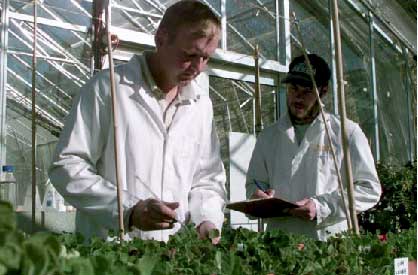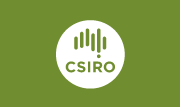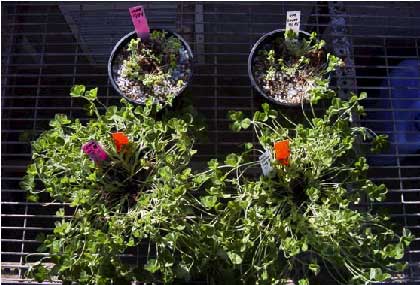GM sub-clover risk assessment
| A Centre for Plant Biodiversity Research study in 2004, within CSIRO Plant Industry, comparing the potential weediness of genetically modified subterranean clover with its conventional counterpart in native grasslands has shown that some differences were present but these were not likely to make the GM sub-clover more weedy. |
Subterranean clover
Subterranean clover, commonly called sub-clover, (Trifolium subterraneum subsp. subterraneum cv. Leura) is a common and economically important pasture plant in Australia. It is favoured for its high quality feed value, ability to fix nitrogen, adaptation to grazing and persistence.
Sub-clover, however, is not able to provide a sulphur rich protein for grazing animals like sheep and cattle. This means that some level of supplementation is required which can be costly and time consuming.
To combat this lack of protein researchers at CSIRO Plant Industry have genetically modified sub-clover to add a sunflower gene that increases the available protein in sub-clover to grazing animals.
In early tests the GM sub-clover has demonstrated a significant increase in protein levels, but it is still under development to increase protein levels more and there are no immediate plans for its general release.
 Dr Bob Godfree’s pioneering work on risk assessment in GM sub-clover has shown that the risk of GM sub-clover becoming a weed is no greater than for conventional sub-clover. |
|
The risk assessment
In 2001 CSIRO started a study to determine the ecological implications of genetically modified organisms (GMOs). The study was established on CSIRO funding to gain scientifically based information about GMOs to contribute to decisions about their release into the environment.
Dr Bob Godfree at CSIRO Plant Industry, part of the Centre for Plant Biodiversity Research, took on a project as part of this study to assess the potential ecological impact of GM sub-clover in pastures and native grasslands.
Although sub-clover is beneficial in pasture situations it can be a weed in native grassland communities, which exist only as remnants in Australia. Dr Godfree wanted to see if there was any difference in the competitiveness and invasiveness of GM sub-clover compared to non-GM sub-clover.
The glasshouse trial
The first phase of the trial was done in a glasshouse where the environment could be carefully controlled and monitored. GM and non-GM sub-clover plants were planted out at different densities to assess their growth, competitive ability and survival under different conditions.
For the entire life cycle of the sub-clover different measurements were taken including the weight of plant material, seed weight and survival counts. Results showed that both GM and non-GM sub-clover grew and performed about the same at different densities, except GM sub-clover was slightly less successful at higher densities
The field trial
Following the glasshouse trials a controlled field site was established to observe the behaviour of GM sub-clover in an ecological continuum from pasture to native grasslands. The field trial was licensed by the Office of the Gene Technology Regulator under OGTR license PR150.
Located in the ACT the trial had GM sub-clover planted out in the central 25 by 25 metre plot of a 100 by 100 metre trial area. Extensive precautions were employed including fencing, bird proof netting and a buffer strip to minimise the chance of any GM material getting out of the trial area.
Results from the field trial supported what was observed in the glasshouse – that there is no discernible difference between GM and non-GM sub-clover in respect to their competitiveness and invasiveness.
Seed germination rates, flowering time, plant growth, seed production, seed weight and seed dormancy, were all compared.
Of all the things measured there was no significant difference between the GM and non-GM sub-clover except that GM sub-clover tended to have lower survival rates at higher densities, flowered slightly later and had slightly softer seed.
Soft seed allows the seed to be more quickly ‘released’ from dormancy and ready for germination. In a good year soft seed is an advantage for the plant as a large part of the seedbank can grow in the favourable conditions. In a poor year it’s a disadvantage as many plants die after germination, thus reducing the seedbank.
Overall, however, results indicated that in native grassland situations GM sub-clover populations would decline over time. So the chances of it becoming a weed in this environment are very slim.
In a pasture environment GM sub-clover is similar to non-GM clover and its population is more likely to stay stable over time.
Scientific references:
Godfree, R., et al. (2004). Ecological risk assessment of transgenic pasture plants: a community gradient modelling approach.
Ecology Letters, 7 (11).
Godfree, R., et al (2004). Growth, fecundity and competitive ability of transgenic Trifolium subterraneum subsp. subterraneum cv. Leura expressing a sunflower seed albumin gene.
Hereditas, 140 (3).
Contact:
Dr Bob Godfree | |
|
Research Scientist |
|
Centre for Australian National Biodiversity Research |
Phone: |
+61 2 6246 4956 |
Fax: |
+61 2 6246 5249 |
Email: |
|
![An Australian Government Initiative [logo]](/images/austgovt_canbr_90px.gif)





